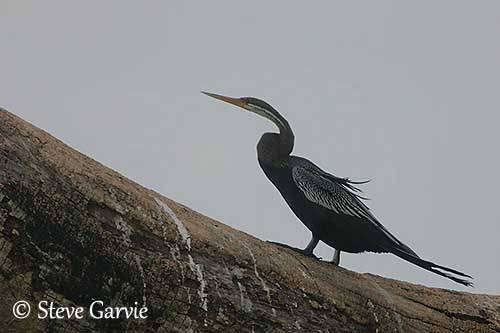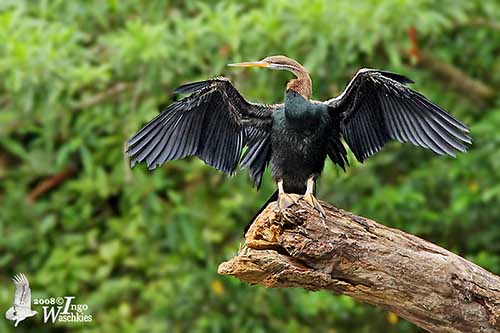
Fr: Anhinga roux
Ang: Oriental darter
All: Indien-Schlangenhalsvogel
Esp: Anhinga Asiática
Ita: Aninga rossa
Nd: Indische Slangenhalsvogel
Sd: Indisk ormhalsfågel
Photographers:
John Anderson
John Anderson Photo Galleries
Steve Garvie
RAINBIRDER Photo galleries
Ken Havard
My Bird Gallery & Flickr gallery 1 & Flickr gallery 2
Ingo Waschkies
My bird pictures on Pbase
Text by Nicole Bouglouan
Sources:
HANDBOOK OF THE BIRDS OF THE WORLD vol 1 by Josep del Hoyo-Andrew Elliot-Jordi Sargatal - Lynx Edicions - ISBN: 8487334105
A Field Guide to the Birds of South-East Asia by Craig Robson. New Holland Publishers. ISBN: 9781780090498
A photographic guide to Birds of the Philippines by Tim Fisher and Nigel Hicks. New Holland Publishers. ISBN: 9781847738301
A photographic guide to Birds of Vietnam, Cambodia and Laos by Peter Davidson. New Holland Publishers. ISBN: 9781847731418
BirdLife International (BirdLife International)
Animal Diversity Web (University of Michigan Museum of Zoology)
Wikipedia, the free encyclopaedia
Page family Anhingidae
Summary cards
Oriental Darter
Anhinga melanogaster
Suliformes Order – Anhingidae Family
INTRODUCTION:
The Oriental Darter inhabits extensive areas of water with large fringing trees. This streamlined water bird is very similar to cormorants in appearance and habits, and can be often seen drying its plumage perched on a branch in the sun, with largely spread wings and fanned tail.
This serpent-like swimmer pursues its preys under water, but when it is swimming at the surface, we usually see only the slender neck and the dagger-like yellowish bill, making the bird similar to a snake emerging from the water.
The Oriental Darter is a Near Threatened species, due to habitat loss, disturbance, egg-collection, pollution, hunting and tree loss at the breeding sites.

DESCRIPTION OF THE BIRD:
Biometrics:
Length: 85-97 cm – Bill: 71-87 mm
Wingspan: 115-128 cm
Weight: 1058-1815 g
The adult non-breeding has dark brown head, neck and mantle. There are conspicuous silvery-white streaks on upper mantle, scapulars and upperwing-coverts. The long tail and rest of plumage are black with greenish-brown tinge.
The throat is paler, mostly creamy-white and mottled black. There is a long, whitish stripe extending from the eye, down sides of the long, thin neck.
The long, slender, pointed bill is yellowish. The eyes are yellow. Legs and webbed feet are blackish.
The breeding adult has blackish crown, hindneck and upper mantle, whereas the foreneck is more chestnut.
Both sexes have fairly similar appearance, but the female is slightly duller, with black-brown to chestnut head and neck instead of reddish-brown. The male has more conspicuous white stripes on the upperwing.
The juvenile has grey head and neck, no white streaking, and rest of plumage browner than adults. The white and black areas are mostly buff and brown.
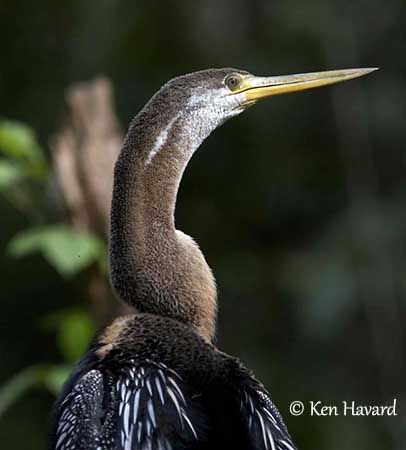
RANGE:
The Oriental Darter is found in Pakistan (Indus Valley), India and Sri Lanka, E to mainland SE Asia, Greater Sunda Islands, Philippines, Sulawesi and W Lesser Sunda Islands.
HABITAT:
The Oriental Darter frequents lakes, marshes and large rivers, including deep estuaries. It usually occurs in trees or bamboos’ thickets near these wet areas, in forested margins or on densely vegetated islets. This species can be seen up to 1200 metres of elevation.
CALLS AND SONGS: SOUNDS BY XENO-CANTO
The Oriental Darter is usually silent, but it becomes more vocal on the breeding grounds where we can hear unusual gruff, slightly nasal “uk ukukukuk-errr uk-uk” or “ok ok ok ok ukukukukuk-err rerr-rer-rub”. These clicking and rattling sounds can be uttered both in flight and from perch. One or more bursts of notes are produced prior to copulation.
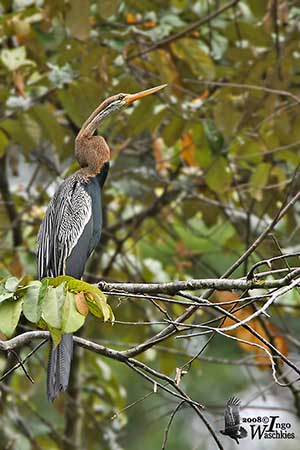
BEHAVIOUR IN THE WILD:
The Oriental Darter feeds primarily on fish, but it also consumes amphibians, reptiles, molluscs, crustaceans, echinoderms and insects. Some plant matter is taken too, including leaves, seeds, grains and nuts, but in small quantities.
It may dive from perch or from water surface and slowly chases preys. It also can wait for fish rising to the surface and it attempts to stretch the neck out, in order to spear the fish. Once the prey is impaled, the Oriental Darter reaches the surface and throws the fish up into the air. This action allows the bird to swallow the fish head first.
Then, the darter perches on branch and dries its plumage by spreading the wings in the sun.
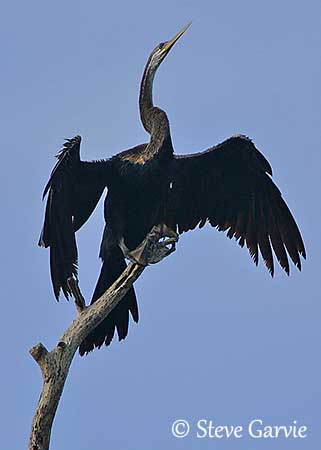
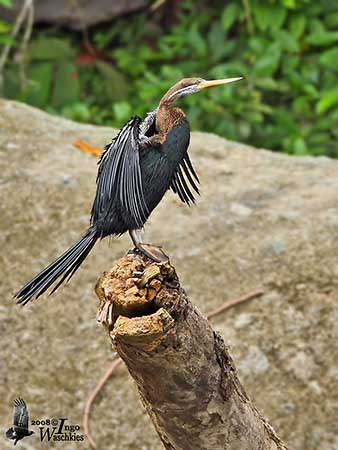
During the breeding season, the Oriental Darter becomes highly territorial and defends nest and chicks by hopping, hissing and snapping when threatened. Conflicts may occur at perches. If an intruder does not leave, fight may occur between males.
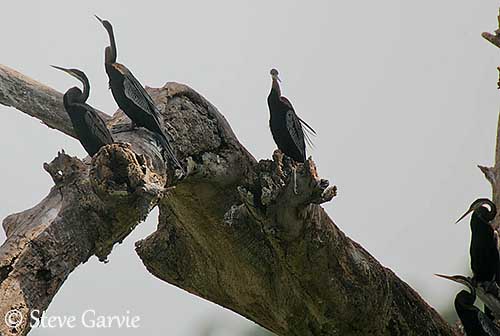
They are monogamous. The male performs courtship displays to attract a female, performing soaring flights and glides. Then, the nest-site is selected and they establish a territory around it. Other displays by male are performed at the nest-site, involving postures and complex movements of body, head, neck, wings and tail.
The “wing-waving” display during which the wings are raised alternately and the neck is stretched out at various angles intensifies when a female perches near the displaying male or flies over it. Once the pair is formed, the nest is built by both mates. The copulation takes place on the nest and both adults share the nesting duties.
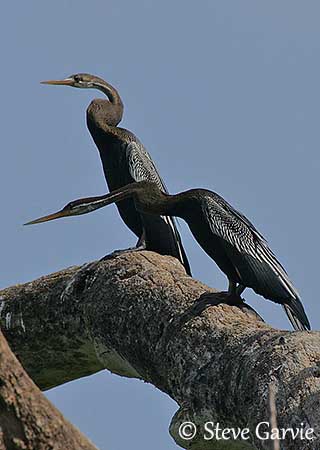
The Oriental Darter is sedentary in its range, and only performs some movements according to drought conditions.
When in flight, it resembles a cormorant. The flight is powerful and it can soar over long-distances without wing flapping. However, unlike the typical sustained flapping flight of cormorants, the Oriental Darter alternates strong flapping flight with glides. It usually uses thermals for soaring.
REPRODUCTION OF THIS SPECIES:
The breeding season can last for several months and even all the year according to water levels. The laying occurs mainly when the water levels are high and the food resources available and abundant.
The nest is a platform made with sticks or occasionally reeds. It is lined with leaves. It is placed in tree overhanging water, often two metres above the water, and can be reused for several following years.
This species usually breeds alone or in loose groups, but the darters may occasionally form large colonies, often alongside other water birds.
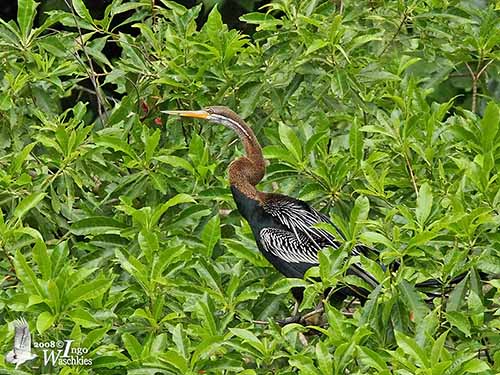
The female lays 3-5 greenish-white to greenish-blue eggs, and both male and female incubate during 25-30 days. At hatching, the chicks are naked, but they are soon covered with white down. They are fed by both parents, first on semi-digested and regurgitated fish, and later, on solid food obtained by forcing head and neck into the adult’s throat. They fledge about seven weeks after hatching and are independent. They will be sexually mature at about two years of age.
PROTECTION / THREATS / STATUS:
The Oriental Darter is threatened primarily by habitat loss on both foraging and breeding areas. Other threats such as disturbance, egg-collecting, pollution and hunting led this species to moderate decline.
The population is estimated at least at 22,000 mature individuals, equating to 33,000 birds in total.
But currently, the Oriental Darter is classified as Near Threatened.
